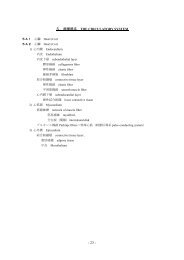Program / Abstract Book - KMU WWW3 Server for Education ...
Program / Abstract Book - KMU WWW3 Server for Education ...
Program / Abstract Book - KMU WWW3 Server for Education ...
Create successful ePaper yourself
Turn your PDF publications into a flip-book with our unique Google optimized e-Paper software.
No. 99 (PO 13)<br />
Drug susceptibility test <strong>for</strong> Giardia intestinalis using WST-1 reagent<br />
Takahiro Matsumura *,** , Tomoji Yuno * , Masaharu Tokoro **<br />
* Department of Clinical Laboratory, Kanazawa Red Cross Hospital<br />
** Department of Parasitology, Graduate School of Medical Science, Kanazawa University, Japan<br />
In human giardiasis, remaining diarrhea after chemotherapy is not rare, due to low compliance with the<br />
therapy, repeated infections or parasite resistance to administrated drugs. Actually, in some clinical<br />
reports, the emergence of drug resistance have been suggested as a cause of treatment failure in<br />
giardiasis, however, the method <strong>for</strong> the drug susceptibility test of Giardia intestinalis and the higher<br />
success rate of isolation method is not yet optimized. In contrast to the field of bacteriology, such as<br />
methicillin-resistant Staphylococcus aureus (MRSA) and penicillin-resistant Streptococcus pneumoniae<br />
(PRSP) etc. Considering these difficult conditions of giardiasis, we have taken a challenge to establish<br />
the metronidazole susceptibility test <strong>for</strong> G. intestinalis. Culture isolation to the axenic condition using<br />
modified YI-S medium (consisting of a nutrient broth, vitamin mixture and serum) of G. intestinalis<br />
was conducted using cysts excreted in patient feces, and 4 out of 6 strains were successfully isolated.<br />
The determination of Giardia genotype was used with molecular biological analysis. Using the<br />
well-grown clinical 3 strains (Su2: assemblage B, Su3: assemblage A, Su4: assemblage A) along with<br />
reference strain Portland-I (PO-1: assemblage A), the metronidazole susceptibility was assessed with a<br />
bioluminescent WST-1 cell proliferation assay (Takara: Japan). The IC50 values of PO-1 and clinical 3<br />
isolates (Su2, Su3, Su4) were 9.36 and 9.45, 6.58, 11.72 (μM) respectively <strong>for</strong> metronidazole. Our<br />
method could isolate both assemblage A and B, common genotypes detection from humans, and the<br />
WST-1 reagent could confirm the drug susceptibility in the culture condition. However, some genotypes<br />
of Giadia have been considered to be difficult to adopt axenic culture condition. So, the best culture<br />
conditions hold the key to the assessment of the drug susceptibility <strong>for</strong> Giardia. In fact, effective drug<br />
choices according to the results of drug susceptibility tests are general protocol in bacterial diseases, and<br />
such a useful assessment method is now available even <strong>for</strong> giardiasis. This study might help to explain<br />
the diversity in drug susceptibility <strong>for</strong> Giardia.<br />
- 152 -



